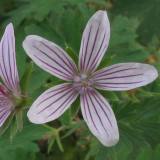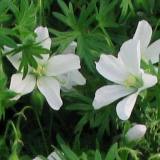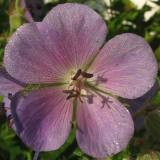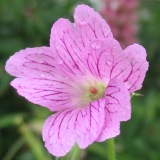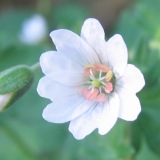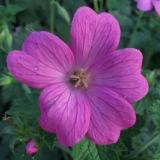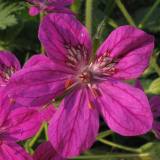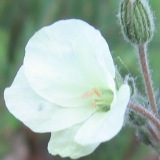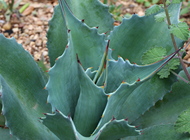 |
Hardy geraniums |
 |
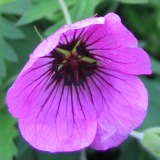 Cranesbills, that's what we're talking about. The genus
geranium and its close relatives, which are perennial in the
temperate-climate garden. That's just a disclaimer, because I don't grow the
tender geraniums (genus pelargonium), however lovely and scented they
may be. Well, OK, they're occasionally featured in the hanging baskets Amy uses
to spruce up the patio, but they don't mingle with the mainstream in the
garden borders. Maybe they will, one day. But for now, our garden only sports hardy
members of the Geraniaceae family. That's cranesbills, and
heronsbills (genus erodium, also known as storksbills). Not that I've
studied cranes, herons, and storks in sufficient detail to tell their beaks
apart, mind you - I'm just repeating what I've been told. Cranesbills, that's what we're talking about. The genus
geranium and its close relatives, which are perennial in the
temperate-climate garden. That's just a disclaimer, because I don't grow the
tender geraniums (genus pelargonium), however lovely and scented they
may be. Well, OK, they're occasionally featured in the hanging baskets Amy uses
to spruce up the patio, but they don't mingle with the mainstream in the
garden borders. Maybe they will, one day. But for now, our garden only sports hardy
members of the Geraniaceae family. That's cranesbills, and
heronsbills (genus erodium, also known as storksbills). Not that I've
studied cranes, herons, and storks in sufficient detail to tell their beaks
apart, mind you - I'm just repeating what I've been told.
The pretext
Most of our geraniums came from seed, traded from far-flung places, and
some from local nurseries and plant swaps. Through the years, we've acquired
a good number of varieties - but this page will hardly be a comprehensive
overview of all the wonderful species, hybrids, and cultivars on the market.
Nope - just the ones growing in our garden. The pretext for putting this
page together was a selfish one - I couldn't figure out just in which ways
all these superficially similar plants growing around the garden were
different from one another. So out came the digital camera, to compare both
leaf shapes and flower forms. The project is far from complete - I hope to
update this page with better photos of plants already in our collection, as
well as with images and impressions of new ones.
Hardy geraniums in the garden
We have members of the family growing in most areas around our property,
from shady nooks to sun-baked borders. For the most part, I've found them to
be very adaptable. Certainly, some prefer more shade and moisture, while others
are more particular about soil drainage - but I've lost very few plants to
a mismatch of cultural conditions. The individual plant portraits, linked from
this page, give a little more information about the specific requirements of
various species.
Making more geraniums
I've never divided geraniums. It probably can be done, but they do a decent
job of multiplying by seed, so I've not felt a need to do so. Still, I may
wish to create more of specific cultivars such as Okey Dokey, so if you
have experience vegetatively propagating geranium species, I'd appreciate your
comments (see the form at the bottom of this page).
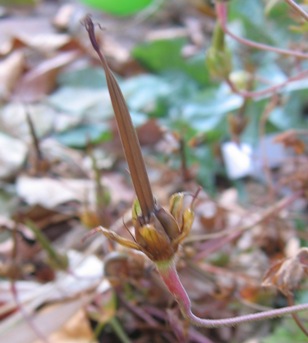
Even though the garden plants regularly make babies, that doesn't necessarily
mean it's easy to grow them from seed yourself. The first difficulty is in
collecting the seed. The "cranesbill" for which the plants are named describes
the shape of the spikes extending from the fruiting bodies left behind when flowers fade. The
seeds are formed in the puffy part at the bottom of the fruiting body.
 The
problem is that the whole assembly was manufactured to serve as a catapult -
when ripe, the seeds are flung out of their dry hull using the spring force of
connective tissue that runs along the spikey bit (this is not a botanically
correct description, by the way). I've received many a trade of geranium "seed"
that consisted of a bunch of empty hulls, the real seeds long gone. It's
obvious enough when you do have a seed - it's a dark brown, slightly oblong
cannonball. Harvest just before they are completely ripe (the pointy bit should
be turning brown) or tie a fabric bag
around the developing fruiting bodies to collect the salvo. The photo at left
shows the fruiting stages of G. wlassovianum, with empty shells in the
two structures on the left, and ripening seeds (ready to go at any time) on
the right.
The
problem is that the whole assembly was manufactured to serve as a catapult -
when ripe, the seeds are flung out of their dry hull using the spring force of
connective tissue that runs along the spikey bit (this is not a botanically
correct description, by the way). I've received many a trade of geranium "seed"
that consisted of a bunch of empty hulls, the real seeds long gone. It's
obvious enough when you do have a seed - it's a dark brown, slightly oblong
cannonball. Harvest just before they are completely ripe (the pointy bit should
be turning brown) or tie a fabric bag
around the developing fruiting bodies to collect the salvo. The photo at left
shows the fruiting stages of G. wlassovianum, with empty shells in the
two structures on the left, and ripening seeds (ready to go at any time) on
the right.
When time comes to actually start the seeds (for me, usually in February,
early enough to have reasonably sized plants by the time mid-May rolls around)
you'll find that some species are easy, others trickier to start. Cold treatments
and/or nicking often help to coax them into germinating. Details for individual
species are once again featured on my individual plant portraits, linked below.
From tiny to quite large
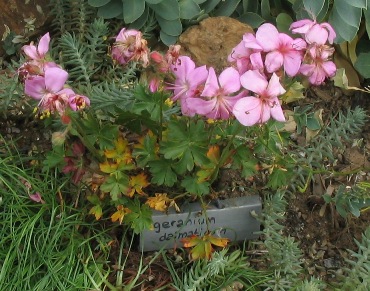
That describes the size range of the kinds we grow. The smallest one is
G. dalmaticum, which we grow in our rock
garden, and grows to only about 4" tall. Most of the others I would describe
as mid-size, growing to around 18" in our garden (although I've seen some of
the same species grow to much larger proportions in gardens that receive more
pampering - so don't take my observations as gospel). The largest one we grow
is definitely G. psilostemon, which gets to
be four foot tall and wider around.
Pretty when not blooming
An important reason for the popularity of hardy geraniums among perennial
gardeners is their long season of interest. While all of them have pretty
flowers, the majority are almost as attractive when not blooming, and several
are grown specifically for their pretty foliage.
The ability to recognize geraniums by their leaf shape was one of my main
reasons to start this project. So in the section below, I present photos of
the leaves of various species - it's easier to see the differences when you
can look at them side by side.
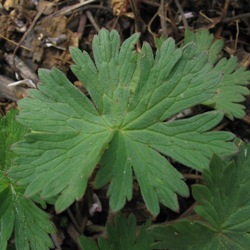
G. asphodeloides has small, tidy, twice-cut leaves, with the first cut quite deep, and an
overall rounded shape |

G. pyrenaicum also has a very regular round leaf shape, but not as deeply
cut |

G. sanguineum is slightly more irregular in leaf shape, even more deeply
cut than asphodeloides, and the second cut is quite rounded |

Leaf shape can be variable. 'Max Frei' is a cultivar of G. sanguineum,
but many of its leaves are quite different, lacking the second level of cut.
|

G. phaeum's leaves are approaching what
I consider mainstream cranesbill: divided into five main sections, each
of which is jaggedly cut. |
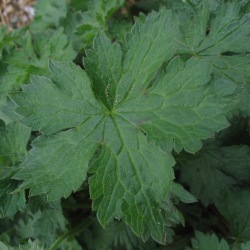
G. 'Wargrave Pink' is typical of geranium, this one sporting darker, slightly mottled leaves.
We bought it as G. endressii, but some argue it's a hybrid of same parentage
as G. x oxonianum. |
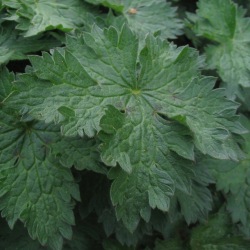
And indeed, G. x oxonianum 'Claridge Druce' looks similar. Its leaves are fairly large, and somewhat purple-tinged in
spring. |

G. wallichianum 'Buxton's Variety''s
leaves are deeply cut and more widely spread, with fairly soft second cuts.
|

G. bohemicum's
leaves resemble those of wallichianum in shape. They are a little hairier,
crinklier, and a fresher shade of green.
|
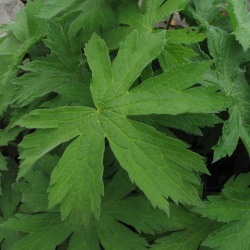
The large leaves of G. psilostemon are among the most sharply cut.
|

G. pratense looks positively frilly, the
second level of indentations extending further down the primary lobes.
|

G. platyanthum moves away from the
mainstream, with less jaggedness to the second cut and a slight hairiness
|

G. macrorrhizum has soft-hairy leaves,
fairly typical of the cranesbill clan.
|

G. macrorrhizum 'Variegatum' features
white-splashed leaves, for a rather different overall image.
|
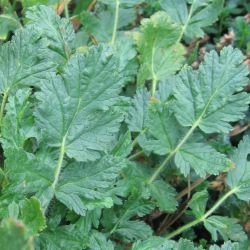
Erodium, while a closely related genus, features rather different leaf
forms. This one is
E. manescavii.
|

Alpine heronsbill is a groundcover
with scalloped, small leaves. |
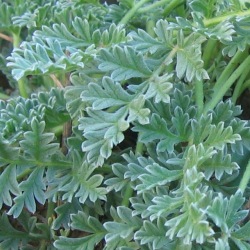
Yellow storksbill's finely cut, grayish
green foliage is probably my favorite among the erodiums we've tried.
|

Colorful leaves
The photos above show off the range of greens featured by "standard"
geranium plants. But many geraniums also shine with a greater color pallette -
some throughout the year, others in fall. I don't have examples of variegated
geraniums just yet (coming soon!), but we do grow a purple-leaved variety of
G. pratense, named Okey Dokey. The leaves
emerge in a dark plum color in early spring, then get a bit greener as the
season goes on.


Fall brings bright colors. Above left, G. wallichianum displays subtle
color gradations; at right, G. platyanthum provides a striking technicolor
range.
Bounty of blooms
Enough about leaves. Most people grow geraniums for their flowers! The gallery
below displays the variety of flower forms and colors of the cranesbills of
our garden. I'll let the pictures speak for themselves.
I hereby withdraw my one-time opinion that the cranesbills are on the
whole rather similar. Although many share a common form, they are quite
different in their leaf and flower forms. Of course, that's merely an excuse
for me to keep on collecting them. So don't be surprised if this page gets
updated rather regularly.
Background reading
Geraniums have been popular garden perennials for a long time, and have lots
of devotees. Consequently, there are lots of good sources of information on
the internet. A good start is provided by the Open Directory Project's geranium
category. For a primer on erodiums,
this page from the UK gives a good overview.
Visitors to this page have left the following comments| Lynn Dean | Nov 05, 2005 | I very much have enjoyed robsplants.com and will be sure to visit your gw member page!
Lynnsherbs |
| Richard Baumann | Jan 24, 2006 | your enthusiam for your plants is an inspiration. I visited your plant sale last year, expecting a large property and multi-greenhouses. was I surprized!!
keep up the good work and I hope to see you again this spring,
(easton, 18045) |
| Helle Madsen | Feb 04, 2006 | I was looking for a picture of a plant on the net, and the your page came up. I am totally overwhealmed by your effort, your enthusiam and the number of plant you make from seed.
Your page is filled with inspiration and ideas.
I would very much have liked to come to your plant sale, unfortunately I live i Denmark, so the trip would be long.
Plan a vacation around it - we're not too far from New York and Philadelphia :-) |
| Joan | Apr 28, 2006 | I have seafched the web, but connot find a picture of Bay Geranium (Ambiosia
Hispidia. Do you know where it is found, and how about a picture?
I'm afraid I've never heard of that species. I'll leave your question up, in case anybody else has. |
| Denise Johnson | May 07, 2006 | I live in Southern California and I absolutely love growing hardy geraniums. I love the way the plants mound, the leaf shape and the lovely flowers. My favorites are Roxanne, Ballerina, and psilostemon. I haven't had much luck growing Ballerina, but it's definitely a lovely plant. If you don't have Roxanne, you need to get it. It's absolutely breathtaking! |
| Rosemary Trombetta | May 08, 2006 | A heartfelt thank-you for your work, especially the very valuable photos you've given those of us who are novices at this delightful, consuming pastime. |
| virginia myerson | May 10, 2006 | Geranium info. well done! I wanted to hear about the pratense type, "Hocus Pocus" that I just purchased without prior knowledge of its performance & Qualities. The plant label shows a bluish/purple flower and says "chocolate-brown foliage," which it now has (it's only a few inches in diameter, purchased from our local greenhouse for $7 ) but your description of "Okey Dokey" says the unusual color will gradually become much more green, much to my surprise!
You refer to the OPen Directory Project to find out more about geraniums, but do not give an address.
Thank you for your reply.(jmyerson@att.net) |
| Sandy | Jun 21, 2006 | Great information. I divide my hardy geraniums all the time to share them with friends. It works best in the spring or the fall. My favorite geranium is "Rozanne"...it flowers all summer. Rozanne does not self seed...but it can be divided.
With two endorsements here, I guess I have no choice but to try Rozanne for myself. I'll be looking out for it... |
| Moonraker (UK) | Jul 03, 2006 | Discovered your website only today & now joining in for a 2nd time. I would echo the sentiments of praise already put forward for your various pages & plant profiles - kindred spirits all of us I think. I agree with Sandy's vegetative method of propagation. I divide most of my herbaceous perennials in Spring - Autumn's o.k. too but I find the plants have a natural tendency to stronger growth from Spring division. As for a favourite Geranium, mine is pratense 'Mrs. Kendal Clarke' - an aristocratic blend of good ancestors. She is pearly grey with beautifully patterned lilac veins. Strong upright habit & flowers profusely. Had I discovered your site last week I could have added a photo of her flowers - now she has gone to seed (picture to Rob) but, if I cut the plant hard back now, she may flower a 2nd time later. Thanks for such an interesting & pleasurable website.
Thanks - another one for me to try! |
| Carolyn, Napa, CA | Oct 21, 2006 | I have geranium maderense (spelling). It's a biennial and it gets huge. |
| Christine, Schwenksville, PA | Feb 19, 2007 | I love your botanically incorrect description of the seeding of geraniums! I have 2 acres, and I'm starting some small garden areas with help and inspiration from my long-gardening (and suffering) parents and husband. I've been amazed, when I walk out in my field, to see geranium leaves everywhere. I moved one into a bed, and it was lovely. So last spring I went out and moved more around. It's much nicer than mowing the poor things down all year! |
| iambloomin | Mar 09, 2007 | z5 garnener here...i simply bury a side shoot late spring and voila, a new plant. I USUALLY flag where Ive intentionally do this, so I know where to retrieve the baby for giving away. Lovin your site :^)
Thanks for sharing, bloomin! I'll have to try that. |
| Annie from Maine | Mar 11, 2007 | I love your website! Question for you, I live in Maine where my relatives had a type of geranium that grew to be a very large roundish bush (4ft x 4ft) with small pink flowers in bloom all summer. I've looked everywhere and can't seem to find it anywhere - the flowers and leaves are similar to cranesbill and mallow (is that a type of geranium) and the claridge druce above too....can you help me pls? Thanks!!
There are certainly cranesbills that fit that habit and description - but without more details or a photo, it will be hard to pin down which one you remember. |
| sharon gleason | Apr 10, 2007 | could you tell us when the best time to start planting geraniums in the spring. Is it too early now if you are next to the house?
I assume you are talking about hardy cranesbill geraniums. In my zone 6 garden, many of those are already showing a nice crop of new leaves. I wouldn't put unhardened seedlings out just yet, but established plants should have no problem with the remnants of early-spring weather. |
| Margret Schreck | May 08, 2007 | I love your website and have enjoyed looking at the pix and reading comments (yours, and those of gardeners who posted their remarks as well). I'm actually on line looking for a source of Cranesbill x Geranium 'Roxanne.' Haven't found one yet...
Thanks for your delightful site!
Margret, Bluestone carry them in their current catalog. I may just have to get some myself... |
| Valerie Hall | May 15, 2007 | Thank you for your very inforative site,I hail from Australia, and knew nothing about this plant |
| Karen Fein | May 16, 2007 | I am a lazy older gardener and for the past two years have s-l-o-w-l-y been installing low maintenance plants in my gardens. This is my first season with hardy geraniums (I got 20 plants of four varieties) and I found you when looking for information on when to cut them back). After reading all your notes, I think I'm going to be planting these little puppies like mad. Thanks fellow Zone 6er! |
| Vicki Skaggs | Jul 02, 2007 | Very nice web pages. I became hooked about four years ago. You can buy 'Rozanne' at www.jungseed.com along with several other hardy geraniums. |
| Moonraker(UK) | Jul 13, 2007 | A year on from my last message I now have a photo of Mrs. Kendal Clarke for you - not the best I'm afraid as I haven't quite got the hang of close-up shots with the new digi-camera yet. Hope to improve my skills by next Summer. More power to your collective gardening elbows all of you out there. (Photo by e-mail to Rob as cannot attach to this note).
Thanks for the photo, Moonraker! |
| Susan Kane | Aug 09, 2007 | Can I keep my potted Geraniums for next year? Maybe bring them indoors by the first frost? Help??? New Gardner in Denver. |
| nicole marillier (France) | Sep 29, 2007 | this was a great idea to show all the leaves next to each others, a great help indeed ! about propagating, I never tried the seeds, always divided the plants; there is also another problem, as all geraniums do not have the same kind of roots, and some of them cannot be split , having only one very big root (like a carrot ...) !
by the way, I belong to a French gardeners forum which members have become addicts of your site !
|
| Olivia54984 | Jan 20, 2008 | Rob, As usual, a great look at geraniums! I am just stumbling across your geranium comments at this time. I always wish I lived closer so I could visit your garden. As g. x Rozanne is the PP of 2008, I have been reading up on it.
I regularly divide g. macrophylla which has the big carrot type root alluded to by Nicole. I simply split off a section with crown material. I would think it is even very possible to simply cut the root length-wise from the crown. I often pot them in 4" pots using the peat soil as a potting medium. They get to be bushier faster and put out thicker, fleshier roots. It appears species crosses are sterile for the most part (ex. Rozanne).
I tried Midnight Reiter once and it seemed to become a huge plant blooming profusely only to die off quick suddenly after its bloom. I have heard of others with the same experience with the purple foliaged group of geraniums. Any thoughts on that?
My success with geraniums is highly variable, but I too found that my purple-leaved variety (Okey Dokey) gave up after a season or two. But one experience doesn't constitute a trend :-) |
| Dianne Olsen | Jan 23, 2008 | What a fabulous website - I will recommend it highly to my Master Gardeners and in my column - may your shadow never grow less! |
| Mary Steinbeck., L.I.,NY | Jan 27, 2008 | I love Geraniums. Didn't realize till I read a garden article in Newsday (Sunday, 11/11/07) that they were also perennials. The article raved about the proven hardiness of a specific one, "Geranium Rozanne". The article stated the foliage in the fall is also beautiful!! Since blue is my favorite color (the flower color of this perennial) I ordered some young plants through a mail order catalog, Burpee. Bluestone Perennials also has them. Can't wait to see the outcome. I'm just starting to collect perennials of different types and colors. I hope this one truly proves a "winner". Rob, let me know if you have any suggestions about planting this geranium. Thanks much!! |
| Vivian Dugan | Apr 12, 2008 | Can the Geraniums be left in the garden in winter time, We live in wash state and some time shave sever winters
Most cranesbill geraniums, as opposed to tender pelargoniums, are quite hardy - but you'll have to compare the hardiness range for any particular species against your own zone to be sure. |
| lesle corbin april 2008 | Apr 19, 2008 | i love this site. i just got a collection of 10 hardy geraniums and this site has given me so much info that i can't wait to get started. |
| Francine Harvey | May 11, 2008 | I loved looking at all different pictures of what is becoming one of my favourite plants. |
| Jackie Runyan | May 26, 2008 | Dividing geraniums is easy, but expect them to look bedraggled for some time after the surgery. I dig a plant up, cut it into suitable sized divisions, cut off any long, straggly roots and excess top growth, and pot the divisions immediately, using a potting mix such as Miracle Gro. I place the pots in light shade and keep the soil damp. The plants look so pathetic for a few days that sometimes I almost wish they WOULD die--but almost all of them survive. I have had especially good luck with Biokovo and New Hampshire Purple. |
| Nina West | Jun 01, 2008 | Love this site. Thank you!!! Can you tell me if and when I should cut back my g. psilostemon. It is looking rather leggy at the moment with only a few blooms. I live in zone 4 (near Boston). I assume I should cut back after flowering but not sure, I would love your advice.Thanks
Yes, cutting back after flowering would be my advice. It starts out with just a few flowers early on, but I think you'll see many more in the next few weeks. I you don't plan on collecting seeds, you can cut back when the main flush is done. |
| Kerry | Jun 23, 2008 | Does anyone have experience with growing cranesbill in a dry shady spot? I live near Denver. |
| jayd | Jun 28, 2008 | Hi Just like to say I have has sucess in dividing hardy geraniums |
| Harry | Jul 22, 2008 | It's the "weeds" growing in around and all over the place in my more than 40 plus Geraniums. I'm 81 so I don't mind getting down and pulling the little devils out, the problem is getting up again. Been a prof.grower since 1947. Growing Hardy Ger. for at least 20 years. I cut the way back after flowering. Was getting seed from So.Africa, but gave that up. Great job on your photos. Kind of dry here near Martins Creek, Pa. Your in Pa. near where???
Hi Harry - I sure hope I'll still be pulling weeds at 81! We live near Trexlertown. |
| Tina B | Jul 30, 2008 | I work in a nursery in the St Louis area and we are finding that these plants have a hard time when the temps start soaring. Would you think if we start cutting them back in pots as soon as they stop blooming they would do better. Presently we are placing them in different locations after cleaning up the not so nice foliage and see which plants do better. The plants we have planted in the landscape are doing fantastic although none are in direct sun for more than a few hours.
I'd think part shade would be best for the potted plants, especially after they are done blooming. Of course different geraniums have different needs - some like shade in any situation, others prefer sun (but will do OK with part shade). |
| Carol L. | Aug 12, 2008 | Rob: I am trying to confirm the varietal name of one of my hardy geraniums. I think it is Rosemoor but the old plastic label is broken after many winters in a Toronto garden. It has survived in what has become a very dark site but I am about to move it to a better spot. Violet-blue flowers, very choice, but I think has been somewhat pushed aside since the appearance of Rozanne. Thanks. |
| Ian | Sep 26, 2008 | Very beautiful site! I would like to know if hardy geraniums can thrive in heat (Heat Zone 9-12)? Thanks.
I could look it up on the 'net - but the fact is, I've no experience gardening in those conditions... I'd ask on a well-visited garden forum, for example the geraniums forum on GardenWeb. Good luck! |
| sharon | Oct 01, 2008 | Wonderful photos of the many different varieties of geraniums. I purchased some large plants and tried to divide, but alas none made it. Does anyone have any step by step tips for this. Is it best done in Spring or Fall. How does 'Johnson's Blue' compare to 'roxanne' I read that it tends to flop and that 'roxanne' can get too leggy. Would welome any comments.
I find that more often than not when I get greedy after a plant purchase and try to divide it, I regret the attempt. One of these years I'll learn. I've not grown Johnson's Blue, but it certainly has a rep for flopping. Rozanne's habit can probably be managed with a good strategy of cutting back - you'll find by trial and error what the best methods are for maintaining a suitable habit/shape without sacrificing many blooms. |
| Irene | Jan 25, 2009 | Your site is a keeper. I moved from NY to FL seven years ago. Sad to say I left a 1 acre garden...zone 4b to a hot backyard condo yard in zone 9. I love to challenge plants...to grow where I go. I brought G. sanguineum with me and it does fairly well here in West Central FL. Scenteds do exceptionally well. This year I plan to add a few of the many I left behind. Even Herb Robert grew wild in my garden in NY, and here in the yard is a wild species...clearly a 'cranesbill'...with branching habit, grows about 12" tall with diminutive blue flowers...not unlike Catmint, but the leaf and seedhead are a dead give-away. Thanks for your lovely photos. |
| Penny Knight | Feb 16, 2009 | I came across this site by pure chance and what a delight. I have been growing cranesbill for several years now but only have a small selection. I will certainly try to locate some of the ones mentioned above. They certainly seem to grow well here in North Lincolnshire, England.
|
| Teresa Madden | Feb 23, 2009 | I have just come across your web pages whilst searching for information on how to divide up plants. i have some that spread out and have lots of 'children' and others that seem to stay the same! I will let you know if I find how to do it, but meanwhile, from one geranium lover to another, many thanks ! |
| Polly (in England) | Mar 20, 2009 | i will email you some pics of ours. my favourites are the psilostemon for its cerise intense colour, mayflower sim; to birch ? one (a syvaticum type)pos; same plant for the lovely mauve eloquence about it,and what is growing wild here and maybe a garden throw away the phauem morning widow/dusky cranesbill. It has this cottage garden charm and the honey bees adore it, but it is taking over my acid soil garden. My last one I am sure it may be called Bill McKensie, it has the most intense blue flower and lots of them.
I will earmark your site for futer reference.
Thanks Polly - I got your pictures. You grow very lush cranesbills! |
| Josie E. | Mar 21, 2009 | Love your site. Just getting started in Geraniums. Which variety does well in full sun. We are in zone 6 Virginia. Thanks,
Our G. psilostemon and G. sanguineum grow in full sun and do just fine. Most of our others get at least a little bit of shade, but may not actually need it. |
| Jane H | Apr 29, 2009 | Great information on this site. I stumbled on geranium growing by accident when a friend gave me a couple of starters. They love living under my cedar tree's,(the tree's are cut high so there is a lot of light) last year the plants were over 4' tall with blooms that reached 4-5"s across... my question... I'm pretty new to gardening... what do I need to do to propogate more of these. They're spreading slowly but I would like to have a few more to fill inbetween the hosta's? Thanks
How to propagate depends on which species of geranium it is - some spread primarily by seed, others send out runners, and many can be periodically divided to make more plants. |
| Peg in Kentucky | May 31, 2009 | After church this morning a friend handed me a plastic bag containing an herb I've been wanting--and several hardy geraniums "that we've been pulling up, we have so many of them" and I didn't know what to do with the poor things (except that they came out of a shade garden) so I Googled it and came to your site--I have no notion all the delicious trouble I could get into when these also become a passion. Super website. Thank you, especially for the descriptions I can understand--like cannonball seeds. |
| LORIANNE | Jun 04, 2009 | wish there were a site for every plant like this
WE HAVE HEAVY CLAY SOIL THAT STAYS WET AND GERANIUMS ARE ONE OF THE FEW THINGS
WE CAN GROW AND THEY ARE DOING VERY WELL RYE BROOK NEW YORK ZONE 5 ISH |
| lucille | Jun 18, 2009 | My cranesbills never bloom. What am I doing wrong?
No idea. Even cranesbills planted in quite a bit of shade bloom in our garden. But I guess it would depend on exactly which species and what conditions you're providing. |
| Ellie | Jul 19, 2009 | I have g.sanguinium max frei along my walkway. They look great while blooming but as soon as they're done, they start looking "dried up". The leaves toward the bottom turn orange in color. They no longer look healthy, lush and green. This is only their second year. Any advice? I heard I'm supposed to cut them back, but how much? Theyre not huge to start with. Thanks!
I just looked at mine - they're starting to look a bit rangy, but not unhealthy, still green. Not sure what could be causing yours to turn color - too wet or too dry would be my first guesses. |
| jackie runyan | Aug 02, 2009 | Dividing cranesbills is easier if you first cut them back hard so that you don't have to try to peer through all those stems. Dig up some of the roots, making sure that each one is attached to at least one stem with at least a few leaves; plant them the way they were growing (more horizontally than vertically); they will probably take hold and start putting up new foliage within a week. Keeping the soil consistently moist during this time seems to help. For this reason, I like to plant the new divisions in shallow, wide pots full of potting soil that I can keep watered and then, after they have put out new foliage, transplant them to the garden (where they will get the same neglect that the rest of my plants thrive on).
Thanks for sharing the tips, Jackie. That should work well for most cranesbills (the exception being those that grow from deep taproots - which are by far in the minority). |
| Anni | Aug 02, 2009 | Your flower categorization is brilliant. Just what I've been looking for! I searched the web for days looking for geranium varieties with photos. As living in Madeira, cranesbill not so suitable, still searching for pale pinks, apricots non hardy variety. Any suggestions? I'll return here now i know about the library! Mant thanks. |
| Nikki | Aug 07, 2009 | Has any one seen the peachy orange hardy geranium? |
| Carol Womer | Aug 11, 2009 | Love your site. My geranimums bloom beautifully (annual type). However, their foilage yellows and is shriveled. I water them daily, fertilize bi-monthly and have them in full sun. The foilage does better when they are in the shade - no blooms then. I live Zone 7. Days are 90 degrees plus and nights are in the low 70s.
Any ideas?
I think you're talking about pelargoniums (tender geraniums, typically used as bedding annuals). I'm afraid my experience with those is very limited. |
| Kaz | Sep 29, 2009 | As a hardy geranium fan from Colorado, I enjoyed your site very much. Yes, hardy geranium is much more interesting and worthwhile than pelergonium. I am especially happy with Psilostemon and Rozanne (amazing!) among the ones I grow here.
The one variety I tried so many times and failed is "Ann Folkard". I know it needs some protection from sun. But are you successful with this more than three years? If so, what is the secret?
I'm afraid that despite her popularity, I haven't given Ann a try yet. So I can't comment on the steadfastness of her garden performance... |
| Penny | Nov 30, 2009 | I have a nursery in England and one of my favourite geraniums is 'Nimbus'. It's leaves are very fine and delicate. Just gorgeous. |
| Robin | Dec 02, 2009 | What a nice website! I recently "liberated" a plant I found on the roadside in Cape May, NJ. I believe it is a geranium which I am trying to identify and the information here is very helpful. May I e-mail them to you or do you know of a site that offers identification? The flower petals are heart-shaped. The color is a strong pink/purple and the generous "veining" towards the inside of the flower is a hot fuschia/burgundy color. The pistals/stamen area is feathery and purple. It's about 2 1/2 to 3 feet tall. Thanks for any help you can offer and for sharing your insights.
You may certainly try me (use the "contact me" link at the bottom of the page), but I must warn you that, much as I like them, I'm hardly a big expert on cranesbills. |
| Laurrie | Jan 17, 2010 | Geranium wlassovianum has fabulous Fall color. It's a nice enough green plant with pretty lavender blooms and it fills the corner at the curve of my walk all summer... but come autumn it simply blazes. Very clear sparkly wine color brings late afternoon sunlight down to the ground level just as you round the corner. I'm in zone 5 Connecticut. I've divided 3 very young plants into a dozen in just two seasons, and done soft stem cuttings to make a few more. Divisions were much stronger and took off faster than the cuttings.
Thanks for sharing your experience. I've tried G. wlassovianum myself now too, although I'm not sure if the plants I grew from seed are correctly identified. |
| Mary Wildfire | Jan 19, 2010 | Thanks to Rob for the fantastic job depicting both leaves and flowers in easy comparison form, and the other info; and thanks to Lorianne for (sortof) answering my question: given my rather heavy soil with dubious drainage, am I really better off with Brookside, as Bluestone suggests, or could I do well with Nimbus, currently on sale; or should I go with Rozanne? and what about psilostemon, with its height and dazzling purple flowers (though maybe hard to put with other flowers)? The answer, jusging from all the comments here, is that I'll probably have good luck with most of them if I give them a smidgen of shade, and I "need" more than one anyway so I should just get (pant pant) ALL of them. No! I can't spend so much money, this is getting out of hand...I live in zone 6, West Virginia and have lusted after these for years but not planted them before. The wild ones that bloom only in May are common here and already gracing my future shade bed. If anybody would like to comment on my choices, you can email me at wildfire@spectrumz dot com. Thanks, everybody |
| Mary Anne Brady | Feb 02, 2010 | Rob, really nice site and photo's, I have the largest collection of Hardy Geraniums on the east coast, but I am looking for a photo of G. 'Mrs. Kendall Clark' that is in a format that can be really enlarges. I just bought a larger nursery and want to put Mrs. Kendall Clark on my sign (she is already on out work shirts etc.) Any chance you can help me with this?? brady@fctvplus.net hope to hear from you. |
| Patricia Chapman | Feb 05, 2010 | I am searching for some p. geraniums, and found you, wow, thank you people for your comments, most interesting and for the lovely website. will be ordering soon. |
| Peggy Hill | Mar 26, 2010 | I am thinking of planting hardy geraniums in a small bed by our condo in Northeastern Ohio. There is morning sun. Would like a very bright color. Can anyone advise a type of hardy geraniums that might work in clay soil that would work in this area. I am new to hardy geraniums and think the possiblity of having them bloom all summer would be wonderful. This is a great website. |
| Joy S | Jun 01, 2010 | Hello
I live in Va Beach and bought a cranesbill that was half price and half dead 2 or 3 years ago. It has flowered all summer long ever since I planted it and I loved the deep purple flower. But, this year, it is so long and leggy and lanky that is just flops on the ground and lays over everything around it. Thes long lanky "arms" extend 3 feet from the point at which they come out of the ground and flop all over, with blooms at the ends. What do you think the problem is? or is this a problem? It continues to bloom profusely all summer and the foliage is in great shape. It just seems to be acting a little weird and interfering with the bed. Thanks!
Has the border it inhabits become shadier over the years? Have you applied a high-nitrogen fertilizer? Just guessing... |
| Yvonne M | Jun 11, 2010 | So glad I found your site! We got a lot of plants 2 years ago from home buyers who didn't want to keep up the amazingly beautiful garden that came with their home. We had a lot of space and gratefuly took what we could get (three large flatbed loads) although it was summer... Now I love to see what comes up every year. Not everything survived... This whole week It was almost an obsession for me to find out what plant it is that I so enjoy under the mulberry tree (shrub?). Finally I found here the answer: a hardy cranesbill geranium! I think I am a geranium fan now, didn't know there were hardy ones.
I will be checking out your site more....Thanks! |
| Jenny | Jun 17, 2010 | I have wondered for ages about the different types of Cranesbill and you have explained it perfectly for me. Your site is absolutely marvellous and I am a frequent visitor. Many thanks |
| Roslyn | Jun 22, 2010 | I just stumbled on this site because I have several Geranium seedlings (1 year old plants)to find a home for in my garden. All of these were 'winter sown' and the seeds were received in trades. To my surprise, all of them germinated, and the only room I have is shaded but gets some sun in the afternoon for about an hour. So that's my site. However, I have one described as 'Orion' which you have not mentioned. The leaves look like a Geranium, so it will be quite a nice surprise to see what flowers it produces. Note: they have not flowered this year because they are still in the small pots in which they were over-wintered. Perhaps if I get them in soon, I'll have some flowers this year.
Sounds exciting, finding out how each of your seedling crops turn out. Good luck! |
| Rose | Jun 25, 2010 | How wonderful it must be to work in such an amazing garden....just like being surrounded by beautifully colored jewels. |
| Robin Brundage | Jun 28, 2010 | Several years ago I purchased 2 mature plants with purple flowers and deep red/green leaves that look most like the Okey Dokey shown on your website. Each spring new red/purple plants come up surrounding the original two plants. The bed is in full midday to late afternoon sun. In winter, the PA Dept. of Transportation deposits anti-skid and some kind of de-icing "salt" directly on this bed; which has not diminished the plant's re-growth but should I prune the cranesbill/seed part after blooming is finished? Will it re-bloom? Thank you.
Deadheading may encourage modest rebloom in some geraniums. I don't usually bother, so I've no specific advice there. It's amazing your patch does so well under those conditions - while mine usually peter out after a few years, never making offspring. |
| Chris P (in England) | Jul 23, 2010 | I have both Rozanne & Jolly Bee and love them - but I have recently become intersted in beekeeping and I wonder if these sterile plants actually have any nectar for bees. I watch them and, although the bees are attracted to the flowers, they do not seem to stay long on each bloom. I hope they are not wasting their time and energy! Does anyone have any thoughts or knowledge of this subject. |
| anisa cumberbatch | Aug 05, 2010 | I would like to know where i could obtain the upright geraniums, which i have seen all over germany, and turkey whilst visiting, They look absolutely beautiful growing in little window boxes . I am in Melbourne , Australia and wondered if the upright geranium are avaiable here. i am a novice gardener willing to learn as much as i can. |
| Barrie Hayes Cambridge England | Aug 23, 2010 | Thanks for the great information and geranium lover's comments. I am still not quite clear whether Rozanne produces fertile seeds on not, whether it can be layered or not or whether it gas one big tap root which may be split - if so when? I have one plant of this which is great and healthy (at the moment). I also have amongst many others a small, prolific,double mauve one- anyone ideas on the variety/name? |
| Kathy England (Cambridgeshire England) | Aug 29, 2010 | I loved your page and love hardy geraniums. Too far to visit I am afraid, but keep the information coming. I find it invaluable. Thank you so much. |
| Carol (BC, Canada) | Sep 18, 2010 | Thank you for a wonderfully informative site. When we moved to a rural property surrounded by tall evergreens I began looking for perennials that could cope with shady, acidic soil. That's when I discovered hardy geraniums and I love them. Some do very well here; others fall over without much provocation... even a heavy rain will knock them down. Is there a particular fertilizer that that you can suggest that might strengthen the plants to discourage this? G. psilostemon does well... the leaves stay mounded and the flowers wind their way through neighbouring plants. G. 'Wargrave Pink' is one that falls flat.
I'd think that no fertilizer would be better. Certainly, avoid fertilizers with high nitrogen (first number in the formulation), since those will promote vegetative growth, leading to reduced ability to self-support. |
| nancy | Sep 23, 2010 | An enjoyable website! I love informal flower gardens. Did I foolishly replant my geranium last week? It looks to be dying. Will it come back next year?
I expect it will live, if it's kept reasonably well watered for the remainder of this season. Good luck! |
| Wayne Leigh | Oct 06, 2010 | I've just bought 3 hardy geranium bareroots from the internet before I stumbled on this site. I plan to grow them in my 'greenhouse' which is maintained at ~70F all year round (Because I live on the equator!). I hope these these plants will somehow adapt to an endless 'summer' though its not too hot in the 'greenhouse'. |
| Annette (from State of Washington) | Apr 03, 2011 | I ordered some bare root geraniums through the mail and would like to plant them now. They are 5 different varieties and the roots look different for each variety. Some of the roots are easy to recognize but for the rest I am not sure which side is up and which side is down. Thank you.
If you truly can't tell which side goes up, I would advise to plant them in some slightly moist potting soil in a large pot, outside in a shady area, just to keep them surrounded by a friendly environment until they start showing their inclination to put out some top growth. At that point, you can plant them in the plot of the garden you have set aside for them. |
| Nusrat | May 07, 2011 | I didn't find what I was looking for. I need to know when plants pop-out they are very tiny. how to take care of them to make them strong and healthy. What kind of fertilizer to use? Do give them water every day? I just plant the seed in potting soil.
I treat geranium seedlings just the same as any others: I water from the bottom when the top layer of the soil looks dry (usually with a very dilute fertilizer solution), and make sure the seedlings get plenty of light. They go out into the garden after a couple of months. |
| Marje Kelly | May 18, 2011 | I have just bought what was labled pelargonium (lovely colour very small
leaves) I thought it was a hardy plant, I have since been told that there
is no such thing as a hardy pelargonium. Please tell me is this true.
I don't know of any hardy pelargoniums - so enjoy your plant for all it's worth this year! |
| Malcolm (Cobourg, Ontario, Canada) | May 21, 2011 | I found a plant labelled "perennial geranium" this morning at a local plant sale. I had never heard of these before, and was especially intrigued by the small deep cut leaves. Your site was the only place I found closeup photos of leaves and flowers .. so I was able to quickly identify "G. sanguineum". This is a wonderful site. The diversity of flowers and leaves that you have illustrated, has got me very excited to seek out more of these remarkable perennials. Thank you for building this website.
|
| Camberly Gardens Landscape Contractors- | May 24, 2011 | Excellent listing of Geraniums. We especially appreciate the images of leaves for comparison. The web needs more sites like yours! |
| Jenn Kell | Jun 05, 2011 | I was hoping you could give me some guidance. I removed a large clump of Roxanne from my garden and separated it into 10 cuttings, which I transpanted. I transplanted each cutting in and watered them heavily for the past three days. I thought that by now, transplant shock would bewearing off but they still show no sign of life. Dead or alive, what are your thoughts please.
I assume you mean divisions rather than cuttings. If each section was well rooted, I would indeed have expected to see them bounce right back. Are you in the middle of a hot spell? Do they get some shade during the afternoon? If the roots were healthy, I wouldn't give up on them. Keep them well watered (but not waterlogged) for another week, maybe provide some temporary shade if they are in hot sunny places, and hope for the best. |
| Water | Jun 05, 2011 | I live in Southern Tier, NY area. Here, hardy geraniums are invasive and have been a constant problem for me. They spread by rhizomes and even after I cut them, the cuttings sprout in my mulch piles. Pulling them up is difficult as the break at ground level. Its true, that if I let them be they become a very pretty plant. However, it becomes difficult to establish new plants in an area that has been taken over by geraniums. They seem to like dry sunny places with frequent rains.
I wonder what species you grow? None of the geraniums I've grown has ever spread aggressively by rhizomes; they all slowly enlarge their clump, and some do make a bit of a nuisance of themselves by self-seeding prolifically. But I've not noticed any sneaky underground maneuvers. |
| Bruce Birge | Jun 12, 2011 | Lately I've been expanding my gardening into "pot culture." Among the large pots with flowering plants on my front deck are two Cranesbills, called Orion, which prodigiously produces gorgeous blue blooms with some violet veining. So far, they seem to be thriving in these large pots, and are growing outward well beyond the edges of the pots as well as upward (so far about 1 to 1-1/2' in all directions). Do Cranesbills readily lend themselves to pot culture, or at some point do I need to transplant these into the flower beds? I live in Zone 5a.If I leave them in the pots, should I find a protected spot (eg. the garage) for them to overwinter in pots? Also,can these plants be propagated from cuttings or by layering? I'd be greatly interested in your experience with Cranesbill propagation methods other than division or seeds. Thanks!
If you're leaving plants exposed in pots over winter, I would subtract a zone or two from your base zone, and check if the plants are hardy in that colder zone. Some cranesbills should be fine, others may be marginal. If you're concerned about their survival, you could take the pots into the garage, or you could temporarily plant the perennials into the garden (I sometimes use the vegetable garden for this purpose) in mid-autumn.
Most geraniums can be readily propagated by division. Although I haven't tried this, I think cuttings are also fairly readily established. |
| Joan Kemp | Jun 25, 2011 | I love your website & have had some success using your 'baggy' method of germinating seeds. As far as geraniums go, they are one of my favourite plants for their cheerful easy-going adaptability. I am forever splitting bits off plants to propgate - far easier, quicker and more reliable than waiting for seedlings. The most important things are to choose a damp, cool day & ensure that you get at least some root with the division. Keep well-watered, but don't allow to get waterlogged. The 'split' usually sulks for a day or so, but then cheers up & gets growing again. Essentially you are generating pre-rooted cuttings. This technique works well with dicentras, spireas, astrantia and probably many other herbacious perennials.
You're right, dividing is a fine way to make more cranesbills, for most species. There are a few (including G. wallichianum) that grow from a taproot and cannot be readily divided. |
| mothdumpling | Sep 10, 2011 | I have a lovely semi shady woody spot near a japanese maple that I am eyeing to re-do as a mixed geranium border - but the maple/soil has verticillium wilt - will this bump off my geraniums or can they resist it?
also wondering if anyone else is finding their Rozanne to be short lived - I've managed to kill two so far - but it could just be me!
I garden amended clay in Vancouver BC which is zone 7-ish but sort of bi-seasonal - three seasons of soggy rain, and dry summers - in case that impacts my question about re the verticilium wilt. cheers!
I don't know the answer to your question about verticillium - maybe another visitor will chime in. My Rozanne has not been exactly short-lived (it's still around after two years), but I'm underwhelmed by its performance - it has stayed rather insignificant over those two full seasons of growth. Maybe I offer the wrong combination of light and soil resources... |
| subrosa | Sep 20, 2011 | I live south of Vancouver, BC and I grow Rozanne in my garden. It grew so large I had to transplant it to a larger bed to grow between some roses. It is huge, now smothering the roses, and has to be hacked back during the summer. Pains me to remove all those blooms but it is still covered with blooms all summer. No problem with wilt but it is planted in full sun, slightly raised bed, excellent drainage, light soil. I may move it again to an area with poorer soil. It is fairly rich around the roses. Some plants struggle next to the cedar hedge so I may try Rozanne there.
|
| joel adler | Sep 21, 2011 | which would be the best geranium as a ground cover to keep clematis roots cool?I garden in Atlanta, Ga. The site would have morning sun and can be watered.
Any number of geraniums would fit the bill. I'd look at G. wallichianum, G. endressii, G. oxonianum, and G. 'Rozanne' for good choices of lower-growing, reliably perennial cranesbills. Of course I can't vouch for their performance in your warmer climate. |
| plant nut of oz | Oct 02, 2011 | Hi I have just found your site on Hardy Geraniums its terrific,I have a small & modest collection of them.I do have what I think is a type of Cransbill,its only about 12-15" high,has matchstick thin stems,leaves about 11/2" wide horse shoe shaped with serrated edge highly fragrant if crushed & hairy, flowers 1/2 to 3/4 inch across with 5 petals,white with small purple spot,Seed pods like other Cranesbill any idea about its name?
I don't know, but maybe someone else stopping by will be able to identify it. |
| keen geranium gardener of Essex, | Oct 05, 2011 | Just found your site. Really helpful to put with a little "lesson" by Carol Klein on Gardeners World earlier in the year about the different types of geranium. They are a fantastic plant here. I am trying to learn to recognise and propagate. Very confusing! Most labels do not have the full name.... just "geranium"! - so no guide at all, or at least nothing which relates to her main list of 5 groups with different needs and propogation habits - phaeum, pretense,nodosum, sanguineum and psilistemum.. Particularly want to propogate G. Rozanne, G. Johnsons Blue and G. Bill Wallis. Any ideas for success?..... in small steps please for a keen novice!
I have no experience propagating geraniums by cuttings (which would be required for increasing sterile cultivars such as 'Rozanne'), so I can't provide reliable step by step directions. |
| Caroline Walter | Oct 27, 2011 | Do you need to cut to the ground the hardy geraniums for frost or winter? I love this web site, but I can't find what to do in the winter.
You can either cut them back in fall, or wait till early spring. Some are semi-evergreen; I'd leave those in place through winter. |
| Debbie | Nov 18, 2011 | Hi, I guess I stumbled on this site as many others did! Looks very informative! I had a question that perhaps you can answer for me! I live in a Mediterranean area (off skirts of Jerusalem) where the weather is dry for the most part. Fall and winter gets some rain and it does not get below 40 degrees even in the coldest weather. My question was about planting geraniums. I am an amateur gardner since I've been here and have been pretty successful with simply planting and watering plants that I started in several planting beds. However, I found some huge geraniums in a cousin's garden that were falling down because the the branches/flower petals were so heavy. I simply snapped off each flower head with its "branch" and planted into the ground. The soil is claylike and wet from recent rainfall. I just made holes and placed these in with no roots just placed it into the ground as I did from some geraniums I wanted to propagate during the spring that sprouted just fine. I am wondering under these conditions and during this time would these plantings have a chance??
Some geraniums can be propagated from cuttings - but unless you have just the right conditions and weather patterns, you may not be successful using the "stick it in the ground and hope for rooting" method. In any case, you probably know by now whether it worked. Good luck propagating your plants, by whatever method you choose. |
| Bonnie Shepard | Feb 26, 2012 | We have found a plant in Southern California...East Walker Ranch in the Santa Clarita Valley...growing wild where the ground has been disturbed...the leaves are very similar to a cut leaved geranium but the flower is quite different...starts out tight with three lobes...opens up to one flower with reddish-purple on the outside and frilly yellow inside.
If you're trying to find out what it is, my advice is to take a picture and post it on the "Name That Plant" forum at GardenWeb. They're very good! |
| zaks master | Mar 18, 2012 | I was looking to see whether there were any more hardy geraniums then what I already have I already have six different types in my garden they are so easy to grow and a delight to the eye. Anybody reading this give them ago you wont be disapointed. |
| Del | Apr 10, 2012 | Great site! I hope to put in about 5 to 7 hardy 'blueish' geraniums. Going in a berm area. What variety would anyone recommend for a somewhat compact plant, low maintenance. zone 4 (Wisconsin). Will be in next to 30' white Shasta daiseys. Thanks.
I would try G. wallichianum 'Buxton's Variety'. It is deeply rooted, which makes it more drought-tolerant than some others, and doesn't weedily self-seed (although you may find a few volunteers now and then). |
| Del | May 01, 2012 | Building a 14' x 9' 2 level berm. Front (ground level) I'd like to plant about 5 or 6 Snocap daisys (dwarf) and maybe alternate - stagger them with 5 BLUE hardy geraniums (somewhat low and fairly compact. I'm in zone 4 east central Wisconsin. The area involved is about 2 1/2' wide. Any suggestions on variety of cranesbill (?), or pattern of planting? With a few permanent somewhat bigger landscape pieces in background, I'm planning on decorative stone for ground covering. Thanks much! |
| Del | May 01, 2012 | OOps, didn't see theresponse - Thanks. If any changes from the info I added please holler. Full sun area! :) Del |
| Dave | May 10, 2012 | I divided a 3 year old Rozanne geranium this spring (early april) when it started showing some leaves. I dug it up and brushed off the dirt to find five tap roots slightly twisted together. Each root was maybe 4 to 6 inches in length. It didn't look like much of a root system at all. I untwisted and separated the five roots, then planted each one. It was very easy. It has been about one month now and all five plants are 6 to 8 inches wide and growing fast. I have had 10 of these plants over the last 3 year with only some success. The ones in full sun did the worst and failed to return the following year. I may have also killed some last year in the spring with perennial fertilizer and too much water. The ones that did best were in part shade throughout the day and the ground kept slightly moist. I live in Columbus, Ohio Zone 5b.
Thanks for sharing your experience. Once again, my Rozanne is starting off the year quite small and tentative. Maybe I should try to relocate mine and see if it perks up like yours did. |
| califnan | Jun 05, 2012 | I want the Rozanne, but would like to see it before purchasing. Have called around and cannot find it.
Would anyone know of a nursery or grower in So California.
Thanks so much |
| Janice | Jul 01, 2012 | I live in a zone 2 area of central Alberta, Canada, and have a cranesbill nimbus which I planted 3 or 4 years ago in a spot with only a app. 5 inches of soil facing northwest. Am amazed how well it has developed with no special care, never watered or mulched to protect from our bitterly cold winters. It is an amazing plant so this year I am adding a few other varieties of cranesbill to my garden. I am pleased to have found your site and enjoy all the interesting comments! |
| paristrance | Jul 09, 2012 | Hi. I was searching the web looking for info on hardy geraniums and found your site. Wow, so much great information! I was wondering if you cut yours back at the end of the season. I live in Wisconsin and have left my plants alone and while they have survived the winters, they are now 3 years old and looking a little worse for wear. They always look great at the beginning of the season, lots of green leaves and plenty of flowers, but after the first hard rain they no longer stand up on their own. There are still plenty of leaves around the perimeter of the plant, but the center is leggy and a pinkish-gold color. Should I cut them back and let them regrow? I've also never divided mine, but I've noticed this year that there are several new plants popping up on the other side of the sidewalk. My guess is that the birds replanted for me. Looking forward to researching the rest of your site and to hearing your suggestions for my leggy plants. |
| Lee | Jul 14, 2012 | Thank you for the effort you have put into this website. I planted 3 G.Dalmaticum in May (I live in SE Michigan) and they have done very nicely, just putting up some pink flowers. They are planted between established hostas. Then, over the course of a few days, one plant became very droopy and the leaves seem to become very fragile and just break off. I don't think it is water related (it is in a well drained spot with partial sun) - when it first started looking droopy, I watered it but the plant did not respond. I don't water the plants normally except the water they get from a distant sprinkler. The leaves that are breaking off seem to do so about half or a third of the way from the base. I saw one worm in the soil and didn't notice any other bugs. Since the plant got progressively worse, today I cut the plant completely back down to its base. Even the brand new baby leaves are wilting. Some of the stems at the base are darker (brown) but they are not soft so I am not sure if it is fungus.
Any suggestions? Thanks. |
| Norm | Dec 01, 2012 | Hi! Nice site. In the early days I kept getting cranesbills and pelargoniums mixed up because they are both listed as "geraniums" in most nurseries. I know the history behind the naming, but wonder why the industry doesn't do something to fix it; even if the name "geraniums" was discontinued and everyone went with Cranesbills and Pelargoniums? LOL! Anyway, I enjoyed visiting your site. One suggestion I would make is to change your ascending/descending structure for comments so the most recent comments appear first --- it will make your site appear to be more recent and up to date to first time visitors, and to regulars they don't have to wade through a list of comments they already read to get to the new ones. Happy Holidays! Oh, and Pelargoniums are fun!
|
| Sharon de Vries | Feb 28, 2013 | Rob just love the different geraniums. Am working on miniature 1:12 scale paper flower project looking for something special. These are all so different especially like the colour of the Okey Dokey leaves. Do the flowers of the Okey Dokey (G Pratense)only come in white or are there other variations
Thank you It is your love for plants that make our hobby so interesting!!!
I'm sure there are other variations of dark-leaved geraniums that have different flower colors. Unfortunately, these varieties don't seem to last too long in my garden... |
| Terri Clark-Kveton | May 20, 2013 | I love hardy geraniums and some of my favourites aren't mentioned in this article like Katherine Adele (charmin frothiness & gorgeous variegated foliage), Pink Spice (lovely gray green soft foliage),Midnight Reiter (the flowers look fabulous against the dark, dark leaves). I better stop, i could just go on & on... :) |
| Mary Jane | Jun 01, 2013 | Hi There - I bought a bunch of macrozillium (sp?) "whiteness" last year. I put one in shade (under two trees near a water feature previously surrounded by pacasandra. It's doing great - huge and blooming despite very little son. In another, seemingly better spot with afternoon son, they've done terribly. It used to be grass and it's rocky soil, so maybe that's it - poor soil / drainage of both. The astilbe are doing great, but the "Whiteness" leaves are quite small and there are no blooms, nothing. Would it work to transplant them now to the shadier area? Supposedly, these are for full sun to part shade . . . I lost a few tiarella and was thinking of moving a a few of the sad looking ones to fill in the empty spots where the other . Any thoughts as to why I am experiencing failure to thrive with these babies? |
| Elizabeth | Sep 19, 2013 | Interesting comments and site. I came here to research 'Claridge Druce' as it is really pretty invasive in my garden, zone 6 at 4000 ft in the Smokie Mtns of NC. It re-seeds ALL OVER. On the positive side, the leaves look good all season, and the bloom season is very long. It is not rambling and forms a nice mound that gets quite large. It blooms in sun and in shade BTW.
Sandy Mush Herb Nursery has the biggest selection of hardy geraniums I have found. |
| sarah | Dec 29, 2013 | I have a 4 year old pelargonium 4 feet tall. Keep it in the winter. Will it keep living year after year |
| Jeff Clarke (UK) | Mar 18, 2014 | I was very pleased to find your website. I run a very amateur plant stall raising money for a charity, originally stocked with surplus plants items from my garden but now I also have many donations of unwanted plants from other gardens. In many cases no-one can remember the name of the plant and as I don’t like selling unlabelled plants I have to try and identify each plant. I have always liked hardy geraniums in my garden, primarily because they appear to be immune to snail and slug damage – a major problem in my garden (and in most of the U.K.). I now have about 16 types (not counting the various Geranium weed species which are common here). I have had several donated geraniums which I have struggled to identify, and until now I had not found a website which gave me any meaningful information. At least your site with the useful pictures has at least allowed me to have a guess as to the identity of most of these plants.
Like you I have had difficulty with the correct identity of “Wargrave Pink”, and I also have some similar plants which may be G. endressii, G. oxonianum varieties or even something else, and I am coming to the conclusion that in many cases once the correct identity of a plant is lost it is almost impossible to re-identify it with any degree of confidence.
In regard to dividing Geraniums, I frequently receive donations of large chunks of Geraniums and these need to be divided to be put into pots for sale, and I also have equally large areas of Geraniums in my garden which occasionally get too large and even encroach on the paths. Division in spring seems to be trouble free, but with a bit of extra care I find that in the growing season Geraniums can be divided successfully at any time.
I also find that some species will survive happily in pots for many years – too many species to list here!
As an aside I also manage to propagate Erodium manescavii from seed in most years but I find that I have to be careful not to miss the collection of ripe seed.
Thanks for sharing your experience, Jeff. Sounds pretty similar to mine. Only a few geraniums reliably persist in my garden – mostly the weedier ones, of course! |
| Lynn | Apr 07, 2014 | I just planted cranesbill this year. Do they flower the first year? Some of the leaves are yellow. Why?
Assuming the plants you bought were not seedlings, they should certainly bloom this year. The yellow leaves may just be due to stress from transplanting. If they persist, it may be a nutrient imbalance, in which case you should seek local expert advice. |
| Susan Robbins | Jun 22, 2014 | I have a garden if Johnson Blue. I live in Montana, zone 4. Each year I loose 2 or 3plants. Their leaves turn red early on, long before fall, and eventually the whole plant dies. I have replanted three this year. There is some overhead watering from my sprinkler system. Any ideas?
Not from me – perennial geraniums tend to be quite robust in our garden. But other species that have a reputation for being tough, like baptisias, sometimes disappear from our garden for no obvious reason. I guess we all have our challenge plants... |
| Roger Powers | Jul 25, 2014 | Great web page, but I have a question. We live in Phoenix Arizona. We had potted Geraniums outside during the winter months, Now, July, (temps 106-116)I've moved then to 80% shade 20% sun. They are not doing well at all. Will they rebound in fall, or die? They're quite large and I want to keep them. Also can I move them inside (air conditioned) 'til cooler weather?
Yeah, those weather conditions sound far from ideal for cranesbills. I don't know if bringing them inside is the answer, either – while they may survive, the cranesbills I grow are really outside plants that like some space to do their thing. But I've not gardened in a climate like yours; locals may be able to give you better advice. |
| di waterman | Jul 30, 2014 | I am refurbishing my garden in the south of England on the coast and I know cranesbill do well here. Can you suggest several which would keep the flowering period of interest going throughout the late spring and summer months. I love lots of colour and white.
Late spring into summer is great for many different cranesbills. If you're looking for a great billowing effect, meadow cranesbill is a good choice. Other somewhat unruly ramblers include G. endressii, G. oxonianum, G. wlassovianum, and some forms of G. sanguineum. For a tidier habit, try G. cantabrigiense or the smaller forms of G. sanguineum. G. wallichianum blooms later, so is good for mid to late summer color. Try 'm all! |
| Dottie | Aug 09, 2014 | I live in Maine and have several very large and beautiful Rozanne geraniums that always bloom into October. A friend is getting married September 6, and we want to create some hanging baskets with mostly white flowers and a few vines of Rozanne for contrasting color. If we assemble everything the morning of the wedding, would it work to just stick the ends in moist soil in hanging pots? How do they do as cut flowers? Thank-you, and I LOVE your website!
I don't know how it would work – so if I were you, I'd try it right now, see how it works out with a piece about the size of what you'd be using next month. |
| Merl | Aug 16, 2014 | I tried to transplant a blue geranium, I think Johnson's Blue, that had a huge taproot. However, after transplanting the plant curled up and slowly died--all the leaves and stems turned brown. Wondering if I lost the taproot or improperly planted it.
In my experience, it's G. wallichianum that has the most formidable taproots. Even when digging it up in early spring, it is prone to considerable sulking before it returns to a healthy appearance – and in my experience, some don't recover, if I lose too much of the root in the transplanting process. |
| roy shaw | Apr 17, 2015 | I live in England on the pennines a long range of hi altitude hills running down the centre leanth of the country with high rainfall and wind my alpine garden faces east so only gets sun in the morning but my geraniums grow really well after planting I do nothing to them whatsoever except admire them to me a geranium garden is heaven on earth hope everyone has as much luck as I don't pamper them they know what to do best site ever keep posting |
| Kim keeley | Apr 18, 2015 | I have been calling my hardy geraniums by a different name for 20 years. They were on the property and planted by my mother in law. The only reason I started looking was because I could not remember some of my plants and wanted to label them this year. I love my hardy gems.thanks for all the info. |
| Blythe | Apr 21, 2015 | Thanks for this great source of info! Which geraniums are particularly suitable for growing informally around old garden roses (one bed is full sun and one is slightly shaded.) 18" could work but suggestions for 12" or less would be ideal, if there is such a thing. I'm concerned many varieties would be too tall and/or thuggish in rich, fertilized, irrigated soil. Many thanks! Zone 8, Pacific NW (Vancouver Island.)
I'd look into some of the Geranium x cantabrigiense varieties. Well behaved, don't get too tall. |
| Jackson | Apr 29, 2015 | I just wanted to add that I have two large clumps of hardy geranium (not sure of variety, one is pink and one is blue, leaves of one are green, leaves of other are bluish green, both are short, make compact mounds). We live in Indiana, zone 5 but have had really cold winters and nothing kills them. This spring, I dug up both colonies and divided pieces into pots. Each root I planted had small "eyes" so I planted the eyes just below the surface with the small leaves just above the soil surface. They've been terrific, I have about 25 new potted geraniums, each creating a nice little mound and growing like crazy. I'll sell some at market and replant other. Anyway, just wanted to say that dividing was super easy and the geraniums seemed to like it. They seem "refreshed". Love all your info! Jxn |
| pinky | May 10, 2015 | Can Cranesbill Geraniums be grown indoors like regular Geraniums ?
They are really not indoor plants. Some of the shade lovers could probably be kept indoors, but their habit might not be attractive in such a setting. |
| marie | Sep 01, 2015 | I had to add this after I perused your site today and enjoyed it and the comments. I planted 3 Dark Reiter geraniums many years ago (these have dark purplish, large serrated leaves, with bluish purple flowers. I usually have seedlings year after year. I don't use a gas or electric blower in my garden so I tend to have many plants self-seed which is a wonderful way to cheaply propagate favorite plants and some not so favorite too! They do like moisture and a bit of afternoon shade otherwise the oldest leaves turn orange, shrivel and die. Sometimes rabbits sample them when they just come up in spring but if I see that happening I wrap them (the plants, not the rabbits!) in chicken-wire or put pruned-out stems from my rugosa rosebush around the base of the plant until the geranium is taller; soon the rabbits forego nibbling. (just remember that there are thorny stem pieces in the plant later if you like to cut plants down in the fall). Dark Reiter stays erect better than Johnson's Blue, but I still love the latter because that blue color is so blue-beautiful.
Thanks for sharing your experience, Marie! |
| anna | Apr 22, 2016 | I have read that the rosanne geranium is a tough hardy plant and will grow in full sun to part shade. Well I have t o say that I am bitterly disappointed with the information that is given re this plant. My personal experience is that it hates the sun. I keep it well watered and drained and on a dull cloudy cool day it does well, but as soon as the sun comes out and the day warms up this geranium wilts, the leaves scorch and it looks absolutely pitiful. I dont think its a sunny loving geranium at all.
My experience with Rozanne geranium isn't all that great either. But one of the contributing factors to some gardeners' disappointment may be that this popular cultivar isn't necessarily the same true variety at all points of sale. Where the genetics have drifted from the original, the desirable qualities may be diluted to some extent. That's just my hypothesis, I may be wrong. |
| Ann N | Apr 28, 2016 | My mound of germanium came up sparse this year. Clumps surround a dead center. Answers?
Sounds like it would benefit from division and replanting. |
| Terri | May 16, 2016 | When is the best time to transplant Cranesbill?
Similar to most herbaceous perennials, cranesbills are best transplanted during the cooler ends of the growing season: early to mid spring, and mid-late fall. In areas with early and severe winter weather, spring is best. In areas with hot summers and mild winters, fall may be better. |
| kathy | May 26, 2016 | We live in Iowa and have had an unusual hot week. I have had no problems in the past 2 years with my birch's double cranesbill flowers. They are on the west side and we do get lots of sun. This past week they started to droop. At first it was just on a part of the flowers but now the entire flowers are drooping and we continue to have hot days. I thought it might be due to being dry so I watered them each day.Any ideas what the cause would be?
The first stretch of hot weather of the season can stress plants that like it a little cooler. I don't think there's much you can do besides making sure they're not thirsty. If this becomes a pattern, consider moving the plants to where they get some afternoon shade at the end of the summer (or early next spring). |
| Laura | Jul 14, 2016 | I have 2 hardy geraniums in my garden. They are in shapes of balls. When it rains they lay down from the centre of them. Can you tell me why they do this? Is that normal for them
It's not unusual for mounding perennials with a floppy habit to splay open when weighted down with overhead water. As long as they upright themselves once they dry up, it's not a big deal. But some varieties will be stronger-growing than others, so if it bothers you, look for a sturdier replacement. |
| Fiona L-K | Jul 19, 2016 | Gorgeous plants!! Here in Western Australia, we take cuttings and plant them - voila!! Loads of new plants :-D A lot of them still flower through winter!! :-D |
| Ann | Apr 21, 2017 | Can I propagate a geranium by using a stem or the strange thick rhizomes with sprouting leaves?
I was given this and hope I can make it grow. Any tips?
It is Biokovo.
Thanks, Ann
I believe it should be possible, but I have no specific expertise in this area. |
| Barbara Tyrrell | Jun 18, 2017 | I love Johnsons Blue and have had them in various places in my garden for many years. However, last year they produced no flowers, just masses of leave. This year I have had flowers on all of them except one batch which is absolutely flowers and showed no interest in producing any, while the leaves were there in abundance. They are such a lovely colour in the garden and I would love to know why they should have no flowers at all. Would appreciate your advice. Thanks.
Without knowing more about your situation, I can't offer any specific insights. Has your garden become shadier over the years? Have you applied high-nitrogen fertilizer that stimulates leaf production over flower production? It sounds like the plants are healthy, but it may still be worth seeing if dividing them will return them to their blooming glory. |
| jeannette clark | Aug 03, 2017 | What an interesting study! I live on the NE side of Houston, Texas between Crosby and Dayton off of HY 90 in the country. Most of us have 2 acre lots and are in a flood zone. Some of my younger trees have been getting black on the leaves, which I thought was caused by air polution. I had walked over to my other acre this past March, and noticed all these plants growing. I looked down and the color red was all over the stems and some of the leaves. Some little white flowers could be seen. On looking closer, toward the ground, there were all these nodule looking masses growing on the lower stems and even twirled around some leaves, all blood red! I pulled up one cluster or plant and the nodules even were on the root system. I immediately thought, wow! Is this caused by polution or from the soil poluted by flooding? I decided to just watch it's progress. About a week later, it seemed to flourish in red and some yellow colors. Within a couple of weeks I noticed spikes that looked like candles appearing at the top growth. How unusual to see this! I looked up some info on this and the plant was called Bloody Crainsbill and Wild Geranium. On checking the growth a week later the candles started turning greener and a week after that, they turned black, with curled seedlings at the top of the candle. It looked like a chandelier. I found that these seeds were formed at the bottom of the spike(or candle) and designed by Mother Nature to catapult or spring up when ripe to be flung in the air. Thus the chandelier appearance. I read this is the "fruiting stages". What an engineering feat to invent such a process! Further checking, the leaves continued to turn red and yellow. And then, my Grandson got the big mower out for summer, and mowed everything down. This study from "Rob's Plants" was very good! Thanks! |
| Sarah Hackney | Apr 13, 2019 | I found your article very interesting especially the section on leaf shapes. I'm trying to identify a small geranium that has black markings around the centre of the leaf. Any ideas?
Take a look at G. phaeum varieties - I have a few on the linked page, but you'll find many more on an web image search. The real clues will come when flowers arrive – not too long from now! |
| Margie Warden | Jun 15, 2019 | Im looking for the 'spiky" geraniums I have grown for years ! but i didnt record either of their names ...
understated but just a wee treat !! can you help me identify ... ?
I'm afraid that doesn't give me a whole lot to go by. If you can't spot it on this page, chances are I don't know it. |
| Patricia Spitler | Jun 30, 2019 | My 3 yr old Rozanne's blooms this year are opening kind of crinkly, like crepe paper. Don't see any damage on the buds or leaves. Any idea what could be wrong?
No idea. Do they look bad? Do the petals straighten out after they've been open for a while? |
| Carmen Price | May 16, 2020 | I have a border of hardy geraniums....this is their second season. They come in full and green and bloom beautifully, but I am seeing yellowing leaves and leaf spot for the second year. I'm in Zone 4b....the ones in the most sunshine don't do as well as those in the shade. I treat with a fungicide every two weeks. Would replacing the mulch possibly help?
|
| Terry | Jun 27, 2020 | This is a response to Joan, in case in the intervening years she has not discovered the answer to her question. The plant she references has been misnamed, it is not Ambiosia Hispidia, but Ambrosia Hispida. Here is a website for her https://www.fnps.org/plants/plant/ambrosia-hispida |
| Ernest Godwin | Nov 10, 2020 | Geraniums for dry shade include Geranium Macrorrhizum of which there are several different varieties. They will spread and bloom in spring. Also G. cantabrigiense which is less intruding. Robin Parer in CA sells many Hardy Geraniums. |
I welcome comments about my web pages; feel free to use the form below to
leave feedback about this particular page. For the benefit of other visitors
to these pages, I will list any relevant comments you leave, and if
appropriate, I will update my page to correct mis-information.
Note that I discard any comments including
html markups, so please submit your comment as plain text. If you have a
comment about the website as a whole, please leave it in my
guestbook. If you
have a question that needs a personal response, please
e-mail me.
|




 Cranesbills, that's what we're talking about. The genus
geranium and its close relatives, which are perennial in the
temperate-climate garden. That's just a disclaimer, because I don't grow the
tender geraniums (genus pelargonium), however lovely and scented they
may be. Well, OK, they're occasionally featured in the hanging baskets Amy uses
to spruce up the patio, but they don't mingle with the mainstream in the
garden borders. Maybe they will, one day. But for now, our garden only sports hardy
members of the Geraniaceae family. That's cranesbills, and
heronsbills (genus erodium, also known as storksbills). Not that I've
studied cranes, herons, and storks in sufficient detail to tell their beaks
apart, mind you - I'm just repeating what I've been told.
Cranesbills, that's what we're talking about. The genus
geranium and its close relatives, which are perennial in the
temperate-climate garden. That's just a disclaimer, because I don't grow the
tender geraniums (genus pelargonium), however lovely and scented they
may be. Well, OK, they're occasionally featured in the hanging baskets Amy uses
to spruce up the patio, but they don't mingle with the mainstream in the
garden borders. Maybe they will, one day. But for now, our garden only sports hardy
members of the Geraniaceae family. That's cranesbills, and
heronsbills (genus erodium, also known as storksbills). Not that I've
studied cranes, herons, and storks in sufficient detail to tell their beaks
apart, mind you - I'm just repeating what I've been told.

 The
problem is that the whole assembly was manufactured to serve as a catapult -
when ripe, the seeds are flung out of their dry hull using the spring force of
connective tissue that runs along the spikey bit (this is not a botanically
correct description, by the way). I've received many a trade of geranium "seed"
that consisted of a bunch of empty hulls, the real seeds long gone. It's
obvious enough when you do have a seed - it's a dark brown, slightly oblong
cannonball. Harvest just before they are completely ripe (the pointy bit should
be turning brown) or tie a fabric bag
around the developing fruiting bodies to collect the salvo. The photo at left
shows the fruiting stages of G. wlassovianum, with empty shells in the
two structures on the left, and ripening seeds (ready to go at any time) on
the right.
The
problem is that the whole assembly was manufactured to serve as a catapult -
when ripe, the seeds are flung out of their dry hull using the spring force of
connective tissue that runs along the spikey bit (this is not a botanically
correct description, by the way). I've received many a trade of geranium "seed"
that consisted of a bunch of empty hulls, the real seeds long gone. It's
obvious enough when you do have a seed - it's a dark brown, slightly oblong
cannonball. Harvest just before they are completely ripe (the pointy bit should
be turning brown) or tie a fabric bag
around the developing fruiting bodies to collect the salvo. The photo at left
shows the fruiting stages of G. wlassovianum, with empty shells in the
two structures on the left, and ripening seeds (ready to go at any time) on
the right.



















